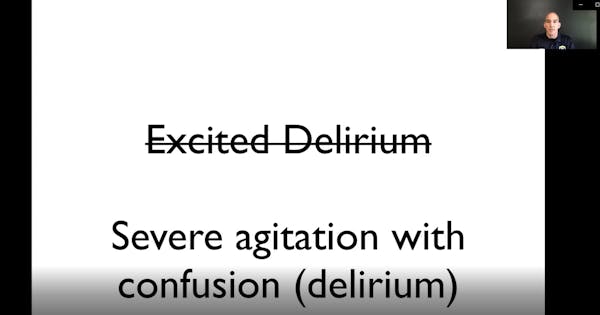Minnesota could become the next state to ban police officer training on "excited delirium," a term that has been rejected by major medical associations in recent years as pseudoscience used to justify deaths in law enforcement custody.
Police officers invoking excited delirium during fatal interactions, such as the murder of George Floyd, have generated a wave of criticism over the term's legitimacy in the United States. Since October, Colorado and California have passed laws prohibiting its use among emergency responders, and more state legislatures are poised to follow suit.
Minnesota's DFL-led House passed a broad public safety bill in April with a provision to ban the state's police licensing board from providing, certifying or reimbursing training on excited delirium. There is now no companion bill in the Senate, so it remains to be seen whether the ban will become law as both chambers negotiate final language in the last weeks of the session, which ends May 20.
Excited delirium usually refers to a person possessed by a potentially deadly form of agitation, sometimes abetted by drug abuse, and displaying aggressive behavior, profuse sweating, public nudity, mouth foaming and superhuman strength. In 2021, the American Medical Association released a statement opposing the diagnosis as "a manifestation of systemic racism." The American Psychiatric Association followed with a similar rejection, and the National Association of Medical Examiners now says it should never be cited as a cause of death.
"Right now, there's not a single medical association that upholds excited delirium as legitimate," said Dr. Altaf Saadi, a neurologist at Massachusetts General Hospital who has called for the end of the term's use in the United States.
Bill author Rep. Jessica Hanson, DFL-Burnsville, declined an interview request for this story. In a committee hearing in April, she described excited delirium as a diagnosis "rooted in anti-Black racism."
"The term excited delirium appeared out of thin air in Florida in the 1980s," Hanson said. "It has no basis in science, no functional meaning in medicine and no clear diagnostic criteria nor symptomatology."
Minnesota's largest police professional association has taken a neutral position on the bill, said Leslie Rosedahl, spokeswoman for the Minnesota Police and Peace Officers Association. In Minneapolis, Mayor Jacob Frey already has banned excited delirium in training for city police.
A doctor in Miami first used the term in 1981 to describe a drug smuggler who died after a bag of cocaine ruptured in his digestive tract. The tear sent a "flood of cocaine" into the man's body, and in the hours before he died, "his behavior became so dangerous that he had to be restrained by six hospital attendants," according to an article in the medical journal Psychology Medicine.
In the 1990s and 2000s, doctors and medical examiners began to use the term more broadly, often to describe people who died in police custody or in jails, including after the use of a stun gun.
Paramedics and police often encounter agitated, erratic people who are difficult to calm and may pose a danger to themselves or others. Critics say excited delirium has become a vague umbrella term to describe a wide array of unrelated causes, used to justify use of force and sometimes delaying appropriate medical recourse for a person in duress.
"The medical support for this diagnosis crumbled," said Dr. Jennifer Brody, an internal medicine and addiction specialist who teaches at Harvard Medical School. "There's just no medical grounds to stand on."
In the past five years, two high-profile cases of people dying in police custody brought new attention from the mainstream medical community to excited delirium.
In 2019, Elijah McClain died after police in Aurora, Colo., restrained him in a chokehold and paramedics injected him with an overdose of the sedative ketamine. The 23-year-old Black man was walking home after buying iced tea, apparently dancing to music on his headphones, when a neighbor called 911 to report he was acting "sketchy." Afterward, the paramedics, who have since been convicted of criminal negligence, said they believed McClain was suffering from excited delirium.
The next year, Minneapolis police officer Derek Chauvin killed Floyd by kneeling on his neck. In a federal civil rights trial, three officers convicted in Floyd's death testified extensively that they believed Floyd may have been suffering from excited delirium. Officer Alex Kueng said he believed the condition could cause Floyd to "spring back to life" and become a threat again, even after he was unresponsive. In a separate trial, Chauvin's attorney argued his client was acting as a "reasonable police officer" watching for signs of excited delirium.
In previous Minneapolis Police Department training, officers were told that excited delirium was an extreme form of agitation that manifests as superhuman strength, bizarre speech and aggressive conduct. A training slideshow, shown to the jury, featured an image of officers subduing a man by pinning him with their knees, similar to how Chauvin pinned Floyd. Officer Thomas Lane, who mentioned excited delirium on the scene, said he was taught to restrain people in such condition in order to "keep a person from thrashing, hold them in place."
Saadi said she hadn't heard of excited delirium before those cases, which prompted her to review the science.
"It's a convenient diagnosis, because on one hand it can be used to justify police brutality, and on the other hand it can also be used to explain sudden death in police custody," she said. "That's how we saw it was being used — in both ways."

Memorial Day weekend travel could come within striking distance of record

Equal rights, abortion protections move closer to landing on the 2026 ballot

Minnesota Legislature's 2024 session ends in anger and acrimony

Minnesota Legislature approves minimum pay for Uber and Lyft drivers


